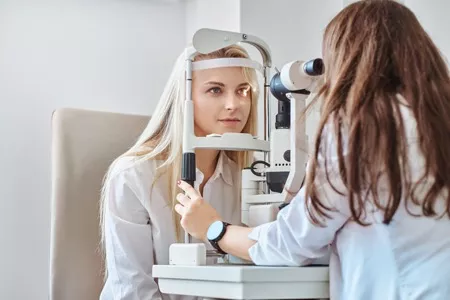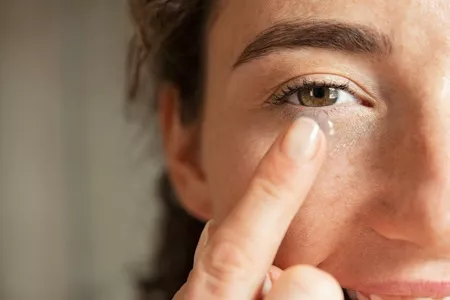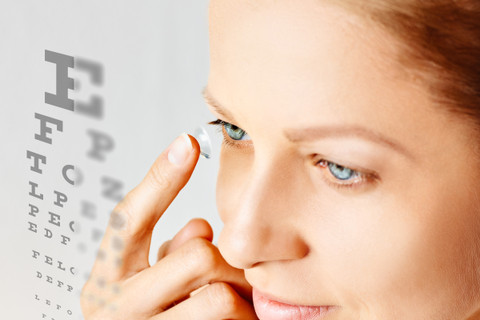Contact lenses have become one of the most popular vision correction options available. If you are thinking of switching from glasses or starting with contact lenses, it is essential to know precisely how to do so. Many people turn to contacts because they feel natural, provide sharper vision, and do not restrict sports or physical activities. However, glasses require less maintenance than contacts, are easier to use, and carry a lower risk of eye infection. The answer to the question, “are contacts better than glasses?” depends on individual lifestyles and peculiar vision needs. So if contacts are your preferred option, this guide from WebEyeCare will teach you how to get contacts that are perfect for your eyes.
What to Know Before the Eye Exam
Regular eye exams are a great way of caring for your eyes and overall health. You also need an eye exam to get you fitted for the correct type of contacts. Going for an eye exam does not have to be distressing or intimidating. Getting ready for the exam by arming yourself with the right information is also part of the process. You should prepare to ask and answer questions about any new symptoms you’ve developed, medications, contacts, glasses, family medical history, vision insurance, etc.
 When you go for an exam for contacts, you will learn about types of contact lenses and what they mean for you. Daily contact lenses are contacts you wear once and dispose of at the end of each day. They are pretty convenient as they require no maintenance.
When you go for an exam for contacts, you will learn about types of contact lenses and what they mean for you. Daily contact lenses are contacts you wear once and dispose of at the end of each day. They are pretty convenient as they require no maintenance.
Monthly contact lenses are designed for continuous wear for up to 30 days but require proper cleaning and storage for safe use. Your lifestyle and preference will determine whether your doctor will fit you for daily or monthly contacts.
Another thing many people who go for eye exams do not know is the kind of eye specialist they need to visit. When you make an appointment to see an eye doctor, you will be meeting an optometrist or ophthalmologist. They are not the same and do not perform the same functions. The optometrist trains to perform vision tests, diagnose eye problems, and prescribe lenses. Optometrists may be licensed to perform specialized surgeries and provide vision therapy in some jurisdictions.
An ophthalmologist is a medical doctor who specializes in treating eye problems. They undergo extensive training that allows them to provide the same medical services as an optometrist and perform eye surgeries and carry out scientific research to find the causes and cures for vision problems. An ophthalmologist can also detect health problems not directly related to the eye during an eye exam.
If you plan to wear contact lenses, you have to undergo an eye exam for contacts to ensure that the lenses fit properly and are safe for your eyes. This exam is not the same as an eye exam.
An eye exam is a comprehensive test that you need, whether you require vision correction or not. A comprehensive eye exam is an integral part of caring for your overall health, as the doctor can detect signs of severe health conditions like diabetes and high blood pressure by examining your eyes. Contact lenses are medical devices and require a separate exam to get contacts that are the right fit for your eyes. You can get a contact lens exam at the doctor’s office.
Your doctor will perform tests to measure the size of your cornea, pupil, iris, and a tear film evaluation to ensure your eyes produce enough tears to wear contacts comfortably.
The Contacts Eye Exam
Here’s what to expect when you get to the doctor’s office for a contact eye exam:
- Questions about your lens preferences
The doctor will ask you questions about your lifestyle to decide which type of lens is best for you. There may also be questions about your lens preferences like daily disposables, contacts for overnight wear, or if you will prefer lenses that change your eye color. If fitting your eyes for contacts is complicated, your doctor may offer hard lenses.
- Taking your measurements
The doctor will first measure your cornea to determine the curve and diameter of your lenses. Next, they will measure your pupil and iris to choose contacts that will fit perfectly and look best on your eyes. The final measurement will be a tear film evaluation, which determines the quantity of tears your eyes produce. If your eyes are not making enough tears, you may not be able to wear contacts safely and comfortably.
- Contact lens evaluation and education
When the doctor has determined the perfect lens for you, a trial pair will be ordered for evaluation while the doctor teaches you what you need to know about wearing and caring for your contacts.
- Follow-up visits
You will have to return to the doctor’s office for further evaluation, so the doctor can check that everything is alright with the trial contacts. If there are no problems, your doctor will write a prescription for your supply of contact lenses. It would be best if you went for an annual contact exam so the doctor can keep an eye on your eye health.
Wearing Contacts for the First Time

Switching from glasses to contacts or using vision correction for the first time can be both exciting and intimidating. Contacts are very safe to use, but it is essential to know what to expect and how to use contacts safely. Your eyes are sensitive, and it may take a few days for them to adjust to your new contacts.
If you are wearing contacts for the first time, you also have to learn how to care for your contacts to avoid putting your eyes at risk. Inserting and removing contact lenses can feel like a daunting task for new wearers. However, you will get the hang of it once you practice it a few times. Learn more about how to put contacts in here.
Where to Buy and How Much Do Contacts Cost?
Where to buy contacts and how much they cost are questions you will probably be asking as a new contact user. You can purchase contact lenses from your eye doctor’s office, local optical shops, and online vendors. You may wish to consider factors like convenience, customer service, selections, and cost before deciding where to purchase your contacts. Contact lenses are medical devices, and you require a prescription to buy from any of these vendors. Ensure you buy your lenses from FDA-approved vendors only.
How much you’ll spend on contact lenses depends on several factors, including your prescription, contact lens material, your replacement schedule, manufacturer’s rebate, discounts, and your insurance plan, among other factors. See our how much do contacts cost article to know what you’re likely to be paying for your contact lenses.
Can I Buy Contacts Online?
You can buy contacts online provided you have an up-to-date prescription. Online retail contact vendors are a convenient option for many people, and they offer a broad range of generic and brand-name prescription contact lenses. Prescriptions typically come with a specific brand type, so you should select the appropriate contact lens brand on the online vendor’s website and provide your prescription details. Browse through our shop to find the best contact lens.
Can I Buy Contacts Without Prescription?
You cannot buy contacts without a prescription from a licensed optometrist or ophthalmologist. All contacts are considered medical devices, and the FDA mandates all sellers (physical and online) to request a valid prescription before selling contact lenses. If you do not have a current prescription, you may be able to complete an online eye exam or use a “doctor’s finder” service to get a prescription. Getting an annual eye exam and contact lens fitting is the best way to ensure you always have a valid and accurate prescription.
Important Things to Know About Wearing Contacts
Contact lenses are prescription medical devices, and there are things you must know about wearing them safely. They rest directly on the eyes, so it’s vital to adhere to specific purchasing and wearing contacts guidelines. You have to understand how to read a contact lens prescription and how to care for your contacts for optimum vision and healthy eyes.
Understanding Your Contact Lens Prescription

Your contact lens prescription holds specific information to help retailers provide you with safe, comfortable contacts that provide you with the best possible vision. A contact lens prescription contains abbreviations and figures that represent your vision specifications, including base curve, diameter, power, cylinder and axis, among other information. Read our guide on how to read your contact lens prescription to understand the details on your prescription and what they mean for you.
Are Contact and Glasses Prescriptions the Same?
Contact and glasses prescriptions are not the same. Contact lenses rest directly on the eye while glasses sit a few millimeters away from the eye, so both require different measurements and tests. Both correct the same refractive errors, but the degree of correction required, contact lens type, and the specified powers can make both prescriptions markedly different. A contact lens prescription includes information that is not found on a glasses prescription, including base curve, diameter, expiration date, and contact lens material or brand. A glasses prescription contains a cylinder and axis value which you won’t find on a contact lens prescription.
The Different Types of Contact Lenses
There are several types of contact lenses, each with pros and cons. Contact lenses are classified based on material type, wearing time, replacement schedule, contact design, among other features. The ideal contact for you depends on your specific vision needs and lifestyle preferences. Learn more about types of contact lenses to find out which contact lens is best for you.
Contact Lens Care for Beginners
Proper contact lens care is vital to effective and safe contact use. New contact wearers must learn how to clean, handle, and store their contacts. Contact lens care covers knowing the right contact care materials to use and the correct cleaning schedule to follow anytime you need to use your contacts.
There are several contact lens care methods, and yours will depend on the type of contacts you wear, allergies, and whether your eyes form deposits. Not adhering to proper contact care guidelines can put you at risk of eye infections and vision loss. Read our contact lens care article to learn how best to care for your contacts.
Conclusion
Many people are switching to contact lenses for the convenience and sharp vision they provide. Contacts make you feel more confident about your appearance, and you don’t have to worry about your contacts falling out, breaking, or getting misplaced.
If you want to get contacts, the first thing is to make an appointment for a contact lens exam to get fitted. Contacts are medical devices, and you must also learn how to use and care for them properly. It might take a while to adapt using contacts, but your lenses will become an important part of your life in no time.
FAQs
Where do I get colored contacts?
Colored contacts allow you to correct your vision and change your eye color simultaneously. You can get colored contacts at your doctor’s office, local optical retail vendors, and online shops.
How long does it take to get contacts?
How long it takes to get your contacts depends on whether the seller has your prescription in stock. You will get your contact within one to two business days if they have it in stock. If your prescription is not in stock, you will have to wait for a few days to a week to receive your contacts.
Why do my contacts get blurry?
Contacts get blurry for several reasons; dirty lenses, dry eyes, contacts out of position, a change in prescription, and issues with your health may be responsible for blurred vision when wearing contacts.
I can’t get my contacts out. What do I do?
Contact lenses, especially soft contact lenses, can get stuck in your eyes if you sleep with them or wear them too long. Do not panic, and don’t try to force it out if this happens. Put a few drops of saline solution or eye drops to lubricate your eyes. With clean hands, slide or gently pinch the contacts out of your eye.
How old do you have to be to get contacts?
Eye care providers encourage contact wear from ages 11 to 14. Children develop fewer complications with contacts than adults. They have stronger immune systems, heal faster, and are often more willing to adhere to contact care guidelines.
How do I get my contacts out with nails?
If you have long nails, you can take out your contacts by using your index and middle fingers to pinch your contacts out from the sides. However, it is better to keep short nails if you wear contacts regularly.
Can contacts get stuck in your eye?
Yes. Contacts can slip out of place and get stuck in your eyes. They can also get stuck if you sleep in them or wear them beyond the recommended time.
Can contact lenses correct my astigmatism?
Yes. Toric contacts lenses are designed to correct astigmatism. The unique shape of a toric lens creates different refractive or focusing powers which can correct astigmatism. Regular soft contact lenses may also be used to correct mild astigmatism.
Can I use one contact lens to correct multiple vision problems?
Yes. Bifocal and multifocal contacts come with more than one prescription on a single lens. Multifocal contacts allow you to see near, far, and intermediate distances with better visual acuity and without the need to alternate between devices, like wearing contacts and using glasses for reading.
 Save yourself from getting into rush hours and buy your contacts online.
Save yourself from getting into rush hours and buy your contacts online.








